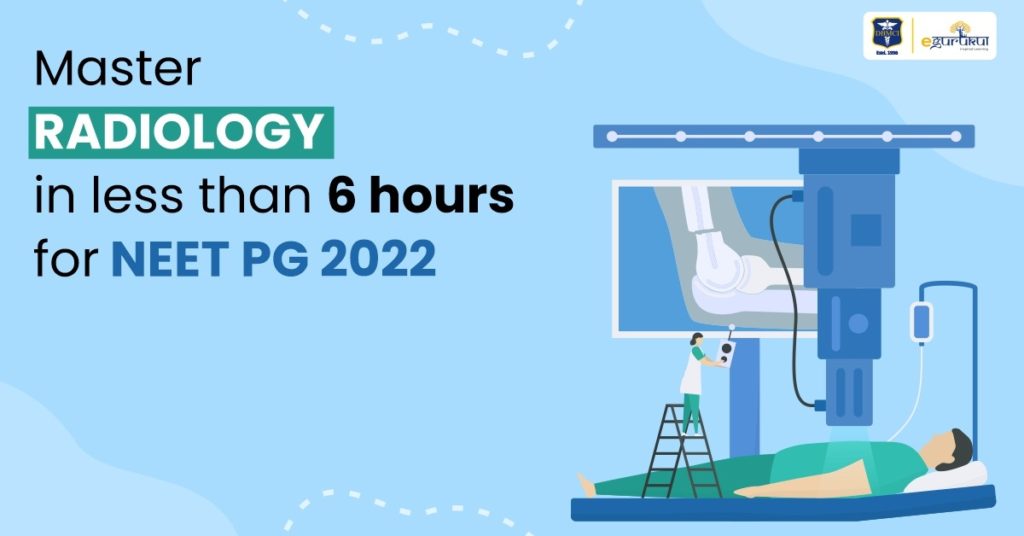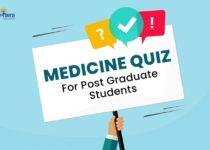Master Radiology in less than 6 hours for NEET PG 2022

NEET PG is a medical entrance examination for students who want to pursue their career in PG Diploma or MS/MD courses in reputed medical universities in the country. The examination is conducted by the National Board of Education (NBE). This year, the NEET PG will be conducted for 19,953 MD (Doctor of Medicine), 10,821 MS (Master of Surgery), 6,102 government, central and private seats, and 1,979 diploma seats for the students in several institutions and universities.
Candidates who want to pursue admission in the MD/MS or PG Diploma can go to the NEET website and submit their applications from 23rd February to 15th March. The admissions have started. There have been several changes in the marking scheme, test centers, exam pattern, and application fee of the examination. All the details can be checked on the NEET-PG website itself.
NEET PG exam syllabus is divided into three main sections. They are Pre-clinical, Para-clinical, and Clinical Services. These sections are further divided into several sub-sections, such as Psychiatry, Anatomy, Biochemistry, Pathology, Radiology, Forensic Medicine, etc. The syllabus of NEET PG 2022 is as follows with the subject-wide distribution:
Subject-wise Distribution of Questions and Sections: NEET-PG 2022
The subject-wise distribution of the questions, sections and allocated marks are as follows:
Section A: 50 marks
| Subject | Marks Allocation |
| Section A – Pre-Clinical | Section A – Pre-Clinical |
| Biochemistry | 16 marks |
| Physiology | 17 marks |
| Anatomy | 17 marks |
| Total | 50 marks |
Section B: 100 marks
| Subject | Marks Allocation |
| Section B – Para-Clinical | Section B – Para-Clinical |
| Microbiology | 20 marks |
| Pharmacology | 20 marks |
| Social and preventive medicine | 25 marks |
| Forensic medicine | 10 marks |
| Pathology | 25 marks |
| Total | 100 marks |
Section C: 150 marks
| Subject | Marks Allocation |
| Section C – Clinical | Section C – Clinical |
| General Medicine (Dermatology & Venereology & Psychiatry) | 45 marks |
| ENT | 10 marks |
| General Surgery (Orthopedics, Anesthesia, and radiodiagnosis) | 45 marks |
| Obstetrics and Gynecology | 30 marks |
| Pediatrics | 10 marks |
| Ophthalmology | 10 marks |
| Total | 150 marks |
Radiology is an essential subject of the NEET PG associated with the advent of new technologies. The subject is fully based on images. Many new techniques and examining methods have come up with the time to give an outlook of a human body, other than CT scan and X-ray. The CT scans and X-rays often overlook the tiniest details of the human body that delays the treatment. Radiology is immensely useful for the diagnosis, examination, and treatment of injuries and diseases through CT scans, MRI, X-rays, PET, fusion imaging, ultrasound, and nuclear medicine. Radiology has become an extensive diagnostic field and has a lot of scope for learning and innovation.
Many candidates or medical aspirants seek to pursue Radiology as their specialization after the NEET-PG examination. The subject is complex. It lays stress on understanding the concepts and reports such as X-rays, MRI scans, CT scans, PET, etc. Students can expect 7-8 questions of Radiology in the examination NEET PG 2022. As per the weightage, General Surgery holds a weightage of 45 marks that includes Orthopedics, Anesthesia, and Radio-diagnosis. Questions from radio-diagnosis, including Radiology + Radiotherapy, consist of 12 questions.
Radiology comes under different various short subjects but is a highly scoring subject if you prepare it in the right way. The right strategy can help candidates ace the subject easily. We will discuss the topics, sub-topics, tips, and tricks that can help you find the right strategy to ace the NEET PG examination.
Topics of Radiology – NEET PG 2022
The topics of Radiology are as follows:
| Imaging of all emergencies | X-rays |
| CT Scan | MRI |
| USG | Radiotherapy |
| Teletherapy | Brachytherapy |
| Systemic Radiotherapy | Nuclear medicine |
| Neuroradiology | Respiratory radiology |
| General Radiology | Systemic Radiology |
| Respiratory | Cardiac |
| GIT | Osteology |
| Head, Neck, and Brain |
Sub-topics of Radiology – NEET PG 2022
The important topics of radiology are as follows:
- Imaging of All Emergencies – This topic consists of various sub-topics, such as Pneumothorax, tension pneumothorax, Pneumoperitoneum, aortic dissection, pneumomediastinum, pneumocephalus, rupture, pulmonary thromboembolism, aortic aneurysms, pseudoaneurysms, ying-yang sign.
- Other topics include:
- Stroke Imaging – Acute infarct, DWI and hyperdense MCA sign.
- Head trauma – subdural hematoma, swirl sign, intraparenchymal, epidermal hematoma, subarachnoid hemorrhage, and intraventricular bleeding.
- Acute Abdomen – acute pancreatitis, volvulus, small intestinal obstruction, and large intestinal obstruction.
- Abdominal trauma – CECT liver lacerations, FAST, splenic injury.
- X-rays -The X-rays include the basic concepts of MAS and KVP, important views of X-ray such as Rhese view, Lordotic view, Waters view, Stryker’s view, Schuller view, Caldwell view, and reverse lordotic view. Other topics include bremsstrahlung radiation, photoelectric effect, Compton effect, mammography technique, conventional radiography, and its differences, unicornuate, didelphys, hydrosalpinx, hysterosalpingography images, normal images, IVP images such as the retrocaval ureter, drooping lily sign, and ureterocele.
- CT scan – The topics include Spiral CT, dual-energy CT, MDCT, HRCT, coronary calcium scoring (Agatston scoring), CT anatomy of brain, abdomen, mediastinum lungs, CT angiography, radiation protection (lead apron), pulmonary thromboembolism, and TLD batch.
- MRI – The topics include MR spectroscopy, coronal sagittal MRI images of the brain, T1, T2, STIR, DTI, FLAIR, DWI, axial, indications, and contraindications.
- USG – The sub-topics in USG consist of piezoelectric effect, FAST, EFAST, EUS, USG elastography, posterior acoustic shadowing and its enhancement, color doppler, uterine artery, fetal Mca doppler, spectral doppler, and umbilical artery.
- Radiotherapy – Radiotherapy is categorized into various divisions as follows:
- Teletherapy – It includes linac, IMRT, electron beam, stereotactic radiotherapy, gamma knife, cyber knife, proton beam, Bragg peak, and craniospinal irradiation.
- Brachytherapy – The topics include pure beta emitters, temporary implants, and permanent implants.
- Systematic Radiotherapy – It consists of P-32, I-131, and strontium-89.
- Law of bergonie and tribondeau.
- Different Iodine Isotopes – I131, I125, I124, and I123.
- Radiosensitivity of tumors and tissues.
- Half-lives of important radioisotopes – P-32, CS – 137, 18F, Tc99m, Iodine isotopes, and CO-60.
- Nuclear Medicine – The concepts include Meckel’s diverticulum, Myocardial infarct imaging, bone scan, myocardial perfusion imaging, thyroid scintigraphy, DMSA, MAG-3 SCAN, DTPA, lingual thyroid, sulfur colloid scan, PET scan Warburg effect, Tc99m – sestamibi scan, pet imaging of heart, 18FDG PET, HMPAO – SPECT, NaF PET, DOPA – PET, DOTATATE – PET, DOTATOC -PET, methionine Pet, octreotide, somatostatin receptor scintigraphy.
- Neuroradiology – The concepts of neuroradiology include imaging of meningioma, arachnoid cyst and epidermoid cyst, TB meningitis, imaging stroke, CT – perfusion imaging, hyperdense MCA, the difference between medulloblastoma and ependymoma, the difference between craniopharyngioma and pituitary adenoma, important names signs such as a racing sign, PANDA sign, hummingbird sign, and mount fuji sign, CJD, penumbra, intraventricular bleeds, subdural, extradural, subarachnoid and intraparenchymal.
- Respiratory Radiology – The sub-topics include normal CXR, collapse, pleural effusion, consolidation, pneumothorax, the difference between PA and AP view, golden S sign, silhouette sign, luftsichel sign, CT images of bronchiectasis, pulmonary alveolar proteinosis, pulmonary edema, x-rays of sarcoidosis, pulmonary thromboembolism, aspergillosis – ABPA, halo sign, air-crescent sign, lucent hemithorax, foreign body, hydatid of the lung, hydropneumothorax, fungus ball, and lung abscesses.
- General Radiology – The topics include the history of X-ray, CT, USG, and MRI, methods of X-ray production, DSA, radiation dose, radiation protection, principles of CT, MRI and USG, components of the X-ray tube.
- Systematic Radiology – Systematic radiology includes various concepts such as normal chest ray, TB, pneumonia, ARDS, pathological conditions like abscess, lung carcinoma, COPD, empyema, pneumothorax, sarcoidosis, hydatid lung, CHD chamber enlargement, TB, achalasia cardia, hiatus hernia, peptic ulcer, Crohn’s and UC, ca oesophagus, diaphragmatic hernia, ca stomach, volvulus, CHPS, colorectal ca, Hirschsprung disease, intussusception, Zenker’s diverticulum, and diffuse esophageal spasm.
- Osteology – It includes bone tumor, osteomyelitis, skeletal dysplasia, fractures, and hemoglobinopathies.
- Head, neck, and brain – It includes the fractured skull, TB, arnoid Chiari malformations, stroke, mammography, metabolic diseases, CT and MRI of brain tumor, the difference between an arachnoid cyst and epidermoid cyst, and neurocysticercosis.
Study Strategy of Radiology – NEET PG 2022
The strategy of studying radiology is as follows:
Some of the concepts that you can learn within 6 hours to Master the Radiology for NEET-PG are:
- Basic Radiology –
- First understand the basics of various techniques, materials used in the x-ray of an image and why that material is used, uses of ultrasonography. Understand the concept of density in CT and why CT is used for that specific case, learn the concepts of exposure, absorption, absorption dose, and units of radiation.
- Go through the basic concepts of radiosurgery such as isotopes, cyber knife, gamma knife, and why isotopes are important clinically half-line isotopes.
- How to calculate the Mas and Ke, and what is the difference between Ke and Mas. Understand the concept, exposure, and contrast between Ke and Mas.
- MRI concepts such as T1 and T2 morphology. Find out what is the difference between grey and white matter.
- Features and legions of T1 and T2. Also, learn how to compare the T2 image with the flare image.
- Systematic radiology – It contains over 150 investigations of choice, signs, and images in the concept. Some of the essential topics to learn before the exam are as follows:
- Learn the clinical-based situations and questions with images such as ultrasound, MRI, CT scans, etc. It is essential for the NEET PG examination.
- Utility of fast.
- Learn how to see a normal chest X-ray, what an ultrasound looks like and how to read it. It is essential not to get confused between abdomen ultrasound and chest ultrasound.
- Make sure to study the ECG changes and CT NGO thoroughly before the exam.
- Another essential concept includes gastro and neuro. Learn and study the images-based questions of the same topics as these types of questions can come in the exam.
Key Points:
- Revise two to three times before the examinations. The first reading might take 4-5 days, and the second reading shouldn’t take more than 6 hours.
- Emphasize the questions with images, like ultrasounds, X-rays, MRI, Ct scans, etc. Learn how to properly read the images and understand them. These questions are most likely to come in NEET PG.
- Make notes of the most essential topics, signs and revise them before the examination.
- Study medicine and radiology from an integrated point of view to understand all the concepts with each other.
- Students often get confused by MRI scans, Ct-scans, ultrasounds, etc. Make sure to study them carefully.
- Your notes and revision shouldn’t take more than 6 hours before the NEET PG 2022.
NEET PG 2022 Result
The results of the NEET PG will be declared on the official website of the NEET, nbe.edu.in. It will be declared in the form of a merit list and will contain AIR (All India Rank) Rank, roll number, and the total marks of the students out of 800. All the candidates are required to have minimum passing marks to clear the round and to secure a place in the next round of the entrance exam. Students who qualify will be called for a counseling session for NEET PG, and the students will be considered for admission to the institutions and universities.
All these concepts can be learned within 6 hours. To understand more and practice the mock tests, you can refer to the DBMCI website. It is a premier medical coaching institute in India that offers e-books, live sessions, and study material for students pursuing the medical field.


